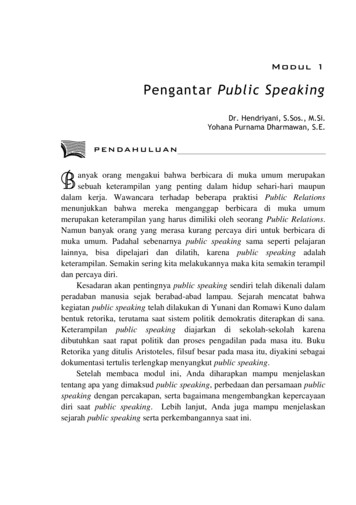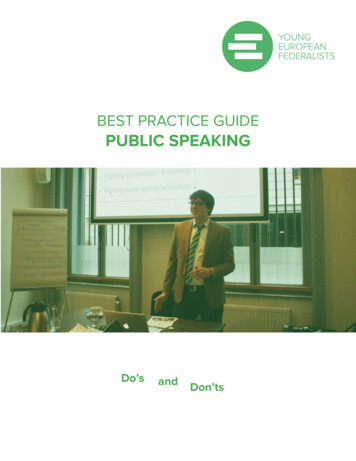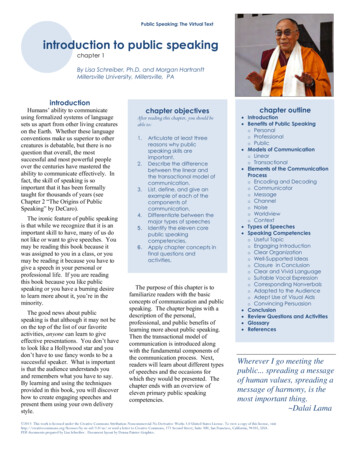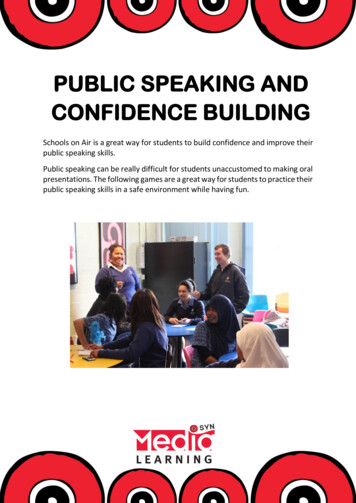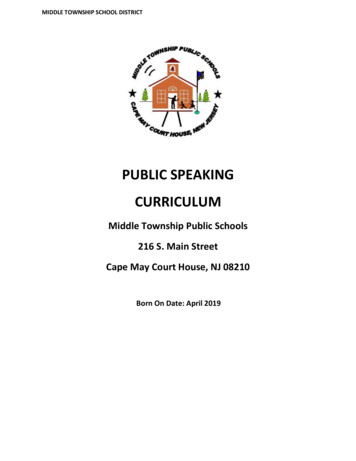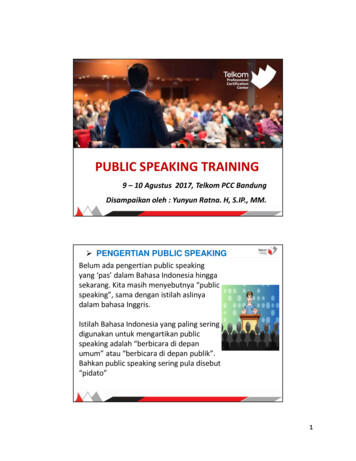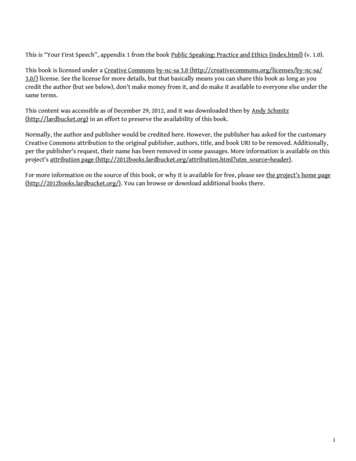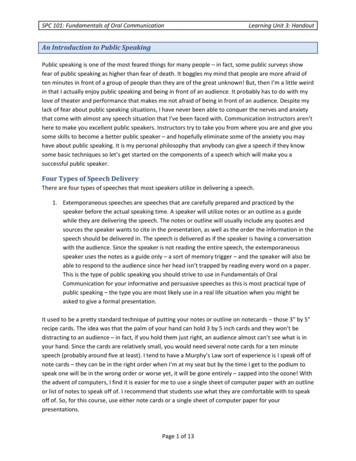
Transcription
SPC 101: Fundamentals of Oral CommunicationLearning Unit 3: HandoutAn Introduction to Public SpeakingPublic speaking is one of the most feared things for many people – in fact, some public surveys showfear of public speaking as higher than fear of death. It boggles my mind that people are more afraid often minutes in front of a group of people than they are of the great unknown! But, then I’m a little weirdin that I actually enjoy public speaking and being in front of an audience. It probably has to do with mylove of theater and performance that makes me not afraid of being in front of an audience. Despite mylack of fear about public speaking situations, I have never been able to conquer the nerves and anxietythat come with almost any speech situation that I’ve been faced with. Communication instructors aren’there to make you excellent public speakers. Instructors try to take you from where you are and give yousome skills to become a better public speaker – and hopefully eliminate some of the anxiety you mayhave about public speaking. It is my personal philosophy that anybody can give a speech if they knowsome basic techniques so let’s get started on the components of a speech which will make you asuccessful public speaker.Four Types of Speech DeliveryThere are four types of speeches that most speakers utilize in delivering a speech.1. Extemporaneous speeches are speeches that are carefully prepared and practiced by thespeaker before the actual speaking time. A speaker will utilize notes or an outline as a guidewhile they are delivering the speech. The notes or outline will usually include any quotes andsources the speaker wants to cite in the presentation, as well as the order the information in thespeech should be delivered in. The speech is delivered as if the speaker is having a conversationwith the audience. Since the speaker is not reading the entire speech, the extemporaneousspeaker uses the notes as a guide only – a sort of memory trigger – and the speaker will also beable to respond to the audience since her head isn’t trapped by reading every word on a paper.This is the type of public speaking you should strive to use in Fundamentals of OralCommunication for your informative and persuasive speeches as this is most practical type ofpublic speaking – the type you are most likely use in a real life situation when you might beasked to give a formal presentation.It used to be a pretty standard technique of putting your notes or outline on notecards – those 3" by 5"recipe cards. The idea was that the palm of your hand can hold 3 by 5 inch cards and they won’t bedistracting to an audience – in fact, if you hold them just right, an audience almost can’t see what is inyour hand. Since the cards are relatively small, you would need several note cards for a ten minutespeech (probably around five at least). I tend to have a Murphy’s Law sort of experience is I speak off ofnote cards – they can be in the right order when I’m at my seat but by the time I get to the podium tospeak one will be in the wrong order or worse yet, it will be gone entirely – zapped into the ozone! Withthe advent of computers, I find it is easier for me to use a single sheet of computer paper with an outlineor list of notes to speak off of. I recommend that students use what they are comfortable with to speakoff of. So, for this course, use either note cards or a single sheet of computer paper for yourpresentations.Page 1 of 13
SPC 101: Fundamentals of Oral CommunicationLearning Unit 3: Handout2. Impromptu speeches are speeches that are delivered without notes or a plan, and without anyformal preparation – they are very spontaneously delivered. This is one of the most nervewracking situations for most students to find themselves in because there isn’t a plan or agendato follow – they just have to get up and speak without any “thinking” time. They are afraid ofnot knowing what to say when they get up in front of the audience so they might make a fool ofthemselves. If this type of speaking situation makes you nervous, you are not alone! The realityis that this is the type of public speaking you are the MOST prepared for. Your daily life is filledwith impromptu experiences and conversations. Every phone conversation, exchange betweenyou and a loved one, and discussion amongst friends is impromptu by its very nature – even ifwe “practice” our conversations, they are still impromptu in their delivery. So, while moststudents are nervous about impromptu speeches, they are the type they are the most preparedfor from their daily experience.3. Manuscript speeches are speeches that are delivered with a script of the exact words to beused. If they have to give a speech, most students prefer to have every single word in front ofthem so they can basically “read” the speech to the audience. While this is very reassuring for aspeaker and they feel like they won’t “forget” anything if they have every word in front of them,manuscript speaking is one of the worst traps to fall into for a speaker. The speaker who utilizesa complete manuscript will often spend more time looking at the script than at the audience. Bydoing this, the speaker is unable to react to the audience or respond to the audience membersquestions. Therefore, the manuscript becomes a trap for the speaker.4. Memorized speeches are speeches that are committed to memory. The speaker completelymemorizes the text of a speech and then delivers the speech from memory without reliance onnotes or an outline. This is a very fearful speaking situation for most people because they fearthey will forget what they had planned on saying when they get in front of the group – and, theymight make a fool of themselves in front of the audience if they forget what to say. This type ofspeaking is not very common to daily living unless you are in a profession like acting. Most of usmemorize very little in our daily lives – we don’t even have to remember telephone numberssince we have cellular phones! I don’t require memorized speeches for Fundamentals of OralCommunication because I think they lead to bad experiences for some students and they arenot something most people have to do in the course of their daily living. Unfortunately, publicspeaking tends to get a bad rap because some junior high and high school teachers requirestudents to memorize speeches which can lead to some bad experiences in front of an audiencefor a student.Vocal Aspects of Speech DeliveryThere are six aspects of vocal delivery a speaker utilizes that influence an audience’s interpretation ofthe speaker’s message.1. Pitch is the highness or lowness of a speaker’s voice. It is the natural upward and downwardmovement that happens when we speak – the melody. Pitch is a learned activity. When youPage 2 of 13
SPC 101: Fundamentals of Oral CommunicationLearning Unit 3: Handoutwere born, you didn’t have pitch but you learned it from the significant people in your life.When your mom or dad talked “baby talk” to you – all that “ga, ga, goo, goo” stuff – they spokeusing a variety of pitches. Your parent used quiet soft tones to bring about a soothing, calmresponse from you or happy, lively tones to bring about a smile or coo from you. As a baby youlearned to mimic the melodies you heard from your parents. This is why family members oftensound alike in their speech tones and patterns – children mimic those that they are around themost. For instance, if you heard my mom, and then myself on the phone, we sound exactlyalike! If you were born without the ability to hear, you couldn’t learn pitch which is why a deafperson who has learned to speak tends to sound monotone – they can’t mimic because theycan’t hear. When it comes to public speaking, don’t try to fight your natural pitch by soundingmore “professional” or more “in charge.” Let your natural melody flow as you deliver apresentation.2. Rate is how fast or slow you speak when delivering a speech. A common problem of nervouspublic speakers is speaking too quickly or feeling like you are rushing through a speech whichcan lead to a cotton mouth feeling. To counter act rushing the presentation, have a bottle ofwater on hand and take a drink when you feel like you are rushing – this should slow you down.Likewise, concentrating too much on slowing down can cause you to drag your presentation. Tryto speak at a natural rate when you are delivering your presentation.3. Pauses are intended silences during a speech. In conversation, we naturally pause at the end ofsentences and at the end of a thought. We should keep up the same pausing pattern in ourpublic speaking that we use in our natural conversation. We can also use pauses to control anaudience that might not be paying attention to the presentation. By taking a little bit longerpause than normal, an audience member will notice the silence and usually stop chatting,whispering, or being disrespectful.4. Volume is the relative loudness of your voice as you deliver a presentation. It shouldn’t come asmuch of a surprise that you need to match your volume to the size of the room you are speakingin. You should also pay attention to your audience – audience members are great about tellingyou when they can’t hear. They will tend to lean forward or look around confused if you are tooquiet. They may even make verbal comments like “What did she say?” or “Can you hear him?”When you see or hear this happening in your audience, speak louder.5. Enunciation is the pronunciation and articulation of words in your speech. Each word iscomposed of syllables which are the little parts of each word that combine together to make aparticular sound. The word “sugar” is composed of two syllables – “Shu” and “gar.” When wedon’t pronounce each syllable in a word, we sound mush-mouthed and don’t sound clear to anaudience. As you give a presentation, concentrate on speaking very clearly and using your entiremouth to form each word. Most of us in our daily conversation are pretty sloppy in our talk – werarely use our entire mouth to converse. In public speaking it is essential to use your entiremouth, speaking extremely clearly while making sure you say each syllable.Page 3 of 13
SPC 101: Fundamentals of Oral CommunicationLearning Unit 3: Handout6. Fluency is the smoothness of your vocal delivery. Fluency is the flow of your words in thedelivery of your speech. You should strive for a smooth delivery in your presentation but if yourtongue gets tripped up, don’t panic. Everyone gets tripped up at one point or another – evenprofessional actors. That’s why there are out-takes on movies! We all stumble over unfamiliar ornew words or even old words we’ve said a thousand times. The trick is to not make a big dealout of the flub when it happens. Just maintain your professional tone and keep going. Thebiggest way to prevent stumbling over your words is to practice, practice, practice yourpresentation so your words are as natural sounding to you as possible.Bodily Aspects of Speech DeliveryThere are four aspects of a speaker’s body which impact an audience’s interpretation of the speaker’smessage.1. Gestures are movements of the speaker’s head, arms, and hands. When you watch a greatpublic speaker, you will notice that their entire body is into the presentation. They use theirentire body to deliver the message – their arms gesture, their fingers point or accent importantwords, and their head even nods when they are talking about something important. Mostpeople think of a podium as wonderful piece of furniture to have on hand when they give apresentation – usually, because it gives the speaker someplace to hide behind! A podium isdesigned for one thing and one thing only – to hold your notes. It is not meant to support yourweight, to be leaned on, or to death grip with your hands. If you hang onto a podium or deathgrip it out of fear, you will not be able to gesture and you will simply be a talking head. Most ofus gesture naturally in our daily conversation. Many of us are accused of talking with our hands.In fact, if you are asked to sit on your hands and have a conversation with someone, you willprobably compensate for the lack of arm/hand gestures by nodding your head or shrugging yourshoulders more than normal! If you have a podium to speak at, set your notes on the podiumand take one step back from it so you can’t hang onto it. This will help you to gesture naturallyand you won’t hang onto the podium. If you hold your notes in your hand, avoid gesturing withthe notes because your audience will logically follow the notes if you wave them around.2. Facial expressions are movements of the eyes, mouth, chin, etc. The best piece of advice aboutfacial expressions is to make them match your subject. If your speaking about a serious subject,use a serious facial expression but if you are speaking about something funny, go ahead andsmile or even laugh. You can ruin a serious presentation by laughing during it and you can ruin alight hearted speech by never cracking a smile.This is a good time to mention humor. Most of us love a good joke but few of us are genuinely funny bynature – just think about how few really great comedians there are in the world. You can certainly usehumor in a presentation but if you are not naturally a funny person, don’t go there because theaudience will know if you are faking it. Likewise, if you are going to use humor, the humor should matchthe subject you are talking about. In other words, if you are going to use “Why did the chicken cross theroad?” you better be speaking about chickens, roads, or what’s on the other side of the road for the restPage 4 of 13
SPC 101: Fundamentals of Oral CommunicationLearning Unit 3: Handoutof the speech. The worst thing you can do is to deliver a joke at the beginning of a speech which doesn’tmatch the content of your speech because it sets the audience up with an expectation about yourpresentation which you can’t then fulfill. It is never a good idea to deceive an audience because you ruinthe trust between a speaker and the audience.3. Eye contact is sustained, meaningful contact with the eyes of audience members. This is the topreason most people hate public speaking – the thought of people looking at you and all the eyeson you is probably the most difficult part of public speaking. There are a whole lot of ways thatpeople will tell you to get around the eye contact issue. Some of the most common myths abouteye contact include:Look only at the back wall in the room, never at the people in the audience. The troublewith this approach is that you completely ignore the audience which makes audiencemembers feel unconnected to the speaker.Pick three spots and only look at those three spots in the room. The trouble with thisapproach is that this takes a whole lot of work – you have to remember where yourthree spots are and where to look next. The audience will feel like you are watching atennis match instead of looking like at them.Look only at the audience member’s foreheads – not at their eyes. Have you ever triedto focus on someone’s forehead? Unless there is some sort of strange growth on aforehead, we don’t focus on this area of a person’s head – we look in them in the eye.Look only at the audience member’s chest – not at their eyes. Okay, in today’s world,focusing on a woman’s chest could get you slapped or thrown in jail so this one is justridiculous.And, my personal favorites think of your audience in their underwear or imagine youraudience naked. The idea behind these is that by imagining them in these states, youshould realize that everyone is the same. My perspective is that if you are imagining aroom full of people naked or in their underwear, what is your speech about? Wouldn’t itbe more productive of you to focus on your presentation instead of what the audienceis or isn’t wearing?So, if you can’t use any of these to survive the eye contact portion of public speaking,how do you survive it? I think the best way to survive eye contact is to understandaudience members because they are who you should be making eye contact with.First, audiences are made up of unique individuals – they are not a homogeneous body whereeverybody is the same. If you understand who is in your audience, public speaking is not nearly asintimidating. Luckily, there are some common types of people who are usually present in everyaudience. If I were going to speak to 25 people, there are a variety of personalities that would be in theroom. Research shows that there will be at least three to five of the 25 who will be clock watchers –meaning they will look at their watch the entire time I am giving the speech. When I give the speech, myego will react negatively with a clock watcher because I will say to myself “Am I speaking too long?” Thereality is the clock watcher is just that, a clock watcher. They may be worried about where they have tobe next and not even focused on how long I’ve been talking. Along with clock watchers, I’m also going toPage 5 of 13
SPC 101: Fundamentals of Oral CommunicationLearning Unit 3: Handoutsee several people doodling. Doodlers are great but as a speaker, I may find them distracting with myego questioning “What are they writing? Is it about me?” Research shows doodlers pay better attentionthan non-doodlers in an audience. They are just adept at multi-tasking so it’s not that they are writingcartoon images of me as the speaker. Along with doodlers will be some people who are sleeping. Myego will question whether I am so boring that I am putting people to sleep but the reality may be thatthose people may not feel well or they had a late night the night before because they work two jobs.This has nothing to do with me or my speech but my ego makes me question it. There will also be agroup of people who will just not care about what I am saying. It really has nothing to do with me – itmay be that they are distracted or worried about something that happened at home. Unfortunately, myego works against me when I look out at the audience and I see all of these people not paying 100%attention to me – I get more nervous. So what should I do? Well, I should look for the friendly eyedpeople in my audience to start my presentation with. They will be there along with the doodlers andclock watchers, sleepers and those that don’t care. If I start with the friendly eyes, I can then work out toothers in the audiences. If I can look around the room and label the audience members as I go, itempowers me as the speaker and keeps my ego in check. When I feel my ego starting to question myaudience, I can go back to the friendly eyes for reassurance that I am doing okay. By looking audiencemembers directly in the eye as much as possible, I validate the audience – they feel connected to me asa speaker and I show them how I value their presence. So, sustained and meaningful eye contact isessential for successful public speaking.4. Movement is where the speaker’s entire body moves. If you can avoid it, don’t let yourself betrapped behind a podium or in one area. When you watch a really great speaker, you’ll see thatthey are almost never trapped behind something. They move around the room as they talk andthat may mean they are down the aisle or all across the front of the room. The biggest place youcan see this happen is by attending a newly constructed church. Most new churches areconstructed to allow for personal interaction between a minister and the congregation which isdifferent than most old churches where the minister or priest is isolated in a pulpit that isprobably higher than everyone else in the room (giving the minister/priest the appearance ofbeing closer to God than the congregation).Writing Your Outline: The Informative Organizational PatternsThere are three major components to any presentation: the introduction, the body, and the conclusion.The natural inclination would be to start writing a presentation with the introduction since this sectioncomes first. However, I recommend that you start writing the body first because the body will determinewhat goes into the introduction and conclusion.The BodyThe body is the heart of the speech – it takes the longest to get through. In an eight minute speech, thebody is between six and seven minutes long. It is composed of three sections: main points, sub-points,and evidence. The body of an informative speech on the legislative process might look like this:Page 6 of 13
SPC 101: Fundamentals of Oral CommunicationLearning Unit 3: HandoutBody:I.Drafting the billA. Sub-pointB. Sub-point1. Evidence2. EvidenceII. Committee hearingsA. Sub-point1. EvidenceB. Sub-pointC. Sub-pointIII. Floor debate on the billA. Sub-pointB. Sub-pointC. Sub-pointMain points are the major ideas you want to discuss about your subject. In the sample above it wouldinclude Drafting the bill, Committee hearings, and Floor debate on the bill.When it comes to choosing a subject, never chose to talk about something you have no passion for.Always choose to speak about something you have experience or expertise with because it makes yourpresentation much more interesting to the audience – you will transfer your passion about the subjectmatter to them!I recommend that you stick with three major main points or aspects of your subject to talk about. Thehuman brain naturally chunks memory into sequences of threes so three main points will be easier foryou to remember (think about the sequence in your telephone number – this is why your phone numberis in sequences of three and then a four). Main points are composed of a combination of sub-points andevidence.Sub-points are your ideas or personal knowledge about the main point you are discussing. This could bea description of your experience or expertise on the subject. In the sample above, the personal expertiseof the speaker could be something they have seen on a trip – on a tour of our nation’s capital to seefloor debate in action.Evidence is the information that you quote or summarize from another source about the main point.This means that you will need to research your subject thoroughly to obtain quality information toquote or summarize in your presentation. Since the speaker in the example above is not a legislator,they would need to research the process and cite the research findings in the presentation.Where to ResearchBecause you are going to have to research your speech topic to learn more about it, it is important foryou to use research from quality sources. For most students, the natural inclination is to use the internetPage 7 of 13
SPC 101: Fundamentals of Oral CommunicationLearning Unit 3: Handoutto research their topic. Unfortunately, the internet is full of a lot of garbage so finding qualityinformation from reliable sources is a challenge. For example, if you were going to research the historyof Barbie and you put Barbie into a Google search, you will connect to about 60% pornography, 30% onwhere to buy Barbie dolls, and 10% on the actual subject you’re researching. It is time consuming towade through the amount of garbage on the world wide web.There is also a huge quality disparity among websites. If I was researching cancer as a topic and onlyusing a Google search, there would be quality difference between Johnny’s Homepage on How I GotCancer In My Big Toe and the American Cancer Society. Because anybody can make a webpage, thequality of the research in general web searches is questionable in many cases.In order to find quality research from reputable sources it is important that you learn how to search forresearch using library databases like Ebsco and ELibrary. These are enormous databases housingthousands of magazine and journal articles, entire texts of books, maps, radio and television transcripts,and a variety of other quality sources. The difference between using a research database and a Googlesearch is that the electronic database will filter out all the garbage and it will give you access to areas ofthe www that you won’t have as a common web surfer. Electronic databases require a very expensiveannual fee to access them – a fee that is included in your IHCC student computer fee so you won’t haveto pay anything to access these as long as you’re an IHCC student. These are the same databases thatstudents at large research institutions like the University of Iowa and Iowa State University have accessto. If you are planning on transferring to a four-year institution, it is very important for you to masterresearching subjects using the electronic databases rather than Google searches.To access the IHCC library’s electronic databases from home, you will need the access codes. FYI – theaccess codes change each semester so you need to use the most current which are always found onyour IHCC My Hills page. The access codes are found on your IHCC My Hills page so click on the houseicon on the left of your screen, print the library access codes, and then proceed to the IHCC Homepage(www.indianhills.edu) to access the library. When you click on the library link, there will be someoptions to utilize including the card catalogue and the library databases. When you click on the librarydatabase link, you will have several databases to choose from. Read the description of the databasesand pick one that matches the type of subject you are searching for. You will be prompted to enter youraccess code if you are searching from your home computer. If you are using an IHCC computer oncampus or at an outlying site, you will not need the access code.Once you have connected to the library database through your access code, you will need to enter yoursubject into a search box. The database will provide you with full text articles, PDF files, pictures, graphs,etc. Since each database works a little bit differently than the others, you’ll have to play around withthem to decide which you like using the best and which generates the most results for your subject.Evidence: Supporting MaterialsSo, what should you look for in your research? Evidence! Evidence is composed of supporting materialswhich are information that support the main ideas of your presentation. They substantiate yourPage 8 of 13
SPC 101: Fundamentals of Oral CommunicationLearning Unit 3: Handoutargument or clarify your position in a persuasive speech and add credibility to an informative orpersuasive speech. Supporting materials you should look for include:Survey resultsTestimonials from eye-witnessesOfficial statements from expertsAnalogies and comparisonsExplanations of phenomenonDefinitions of terminologyVisual AidsDon’t just look for the same type of evidence in your research – a variety of supporting materials willmake your presentation more interesting for the audience! And, you won’t look like you shopped at thesame store for your entire argument!Oral FootnotesEverything outside of your personal experience needs to be cited in your presentation and on yourspeech outline as evidence. An oral footnote is like a footnote or an in-text citation in a research paper.It provides information to the audience about where you got your information and using oral footnotesmakes you credible in the eyes of your audience so it is really important that you use them.An oral footnote always includes WHO said the information, WHERE you got the information from, andsometimes WHEN it was said. Some examples of oral footnotes are:John Smith reported (could also say “said”) that the moon is big and bright in the New YorkTimes on January 1, 2006The moon is big and bright according to (could also say “as stated by”) John Smith, author of OurBig Moon in the New York Times on January 1, 2006According to John Smith, author of Our Big Moon, the moon is big and bright.As found in Our Big Moon by John Smith, the moon is big and bright.By using a variety of the examples above, your speech will be interesting for the audience to hear and itwon’t always sound like your oral footnotes are the same. Variety is a key to public speaking!Organizing the BodyThere are several ways to organize the main points of a presentation. You may choose any of theseoptions or combine the options for a unique presentation. It is a good idea to choose an organizationalpattern that makes sense for your speech topic.Chronological Organization: This would be where the main points of the body are placed in orderaccording to a time line or sequence. This is a good choice for a speech that might be over a person’slife, a famous event, or even a “how to” speech. Our sample speech body on the legislative process is inchronological order.Page 9 of 13
SPC 101: Fundamentals of Oral CommunicationLearning Unit 3: HandoutBody:I.A.B.II.A.B.C.III.A.B.C.Drafting the billsub pointsub point1. evidence2. evidenceCommittee hearingssub point1. evidencesub pointsub pointFloor debate on the billsub pointsub pointsub pointSpatial Organization: This is where the main points of the body are placed in the order you might seethem on a map or in relationship to one another. This is good choice for a speech that might heavilyinvolve using a map or diagram as a visual aid. For instance, I might chose this if my main points wereshowing where each of the concentration camps in WWII were located or if I wanted to show the paththat blood travels through the body. A sample body for a spatially organized speech on weather patternsin the United States might look like:Body:I.II.III.IV.V.Weather on the west coastWeather on the east coastWeather in the southWeather in the northWeather in the mid-westTopical Organization: This is the most popular and flexible organizational pattern for speaking as it isorganized around specific topics. You can choose any combination of main points and put them in anyorder you desire. A sample body for a topically organized speech on the Vietnam Conflict may look like:Body:I.II.III.Economic climate during conflictSocial climate during conflictPolitical clima
fear of public speaking as higher than fear of death. It boggles my mind that people are more afraid of ten minutes in front of a group of people than they are of the great unknown! ut, then I'm a little weird in that I actually enjoy public speaking and being in front of an audience. It probably has to do with my
